Market Timing Indicator (MTI) examples since 1996 based
on Overbought conditions
2002
In the Spring of 2002 after rallying briefly for two weeks
(points A to B) the buying pressure decreased (sloping downward yellow line) and
the %K Line also began sloping downward (solid white line) and the Green Bar
eventually changed to a Red Bar (point C). Over the next three
months the Nasdaq then fell from 1950 to around 1550 for a net loss of 400
points.
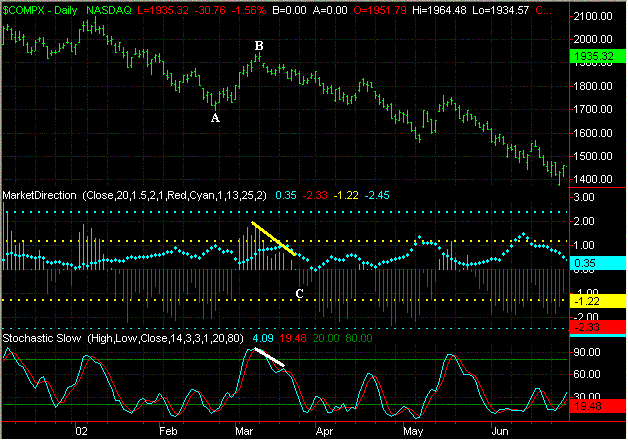
Another example of Overbought conditions coming into play was in
the early part of 2002. As the Nasdaq made a higher high (points D to E)
notice that the buying pressure was decreasing (downward sloping yellow line)
and the %K Line (light blue line) was also trending downward. Meanwhile
the Green Bar switched to a Red Bar indicating increasing sell pressure (point
F). During the next two months the Nasdaq dropped around 400 points from
2100 to 1700.
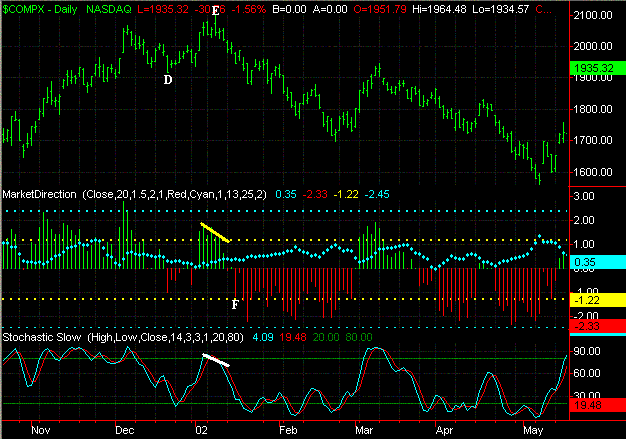
2001
In 2001 the Nasdaq rallied for about four months (points G to H)
but notice that the buying pressure was decreasing (downward sloping yellow
line). In addition the %K Line was also in a downward trend as well (solid
white line). Meanwhile the Green Bar eventually changed color to a
Red bar indicating selling pressure entering the picture (point I). Over
the next three months the Nasdaq then dropped from 2900 to 1600 for a net loss
of 1300 points.
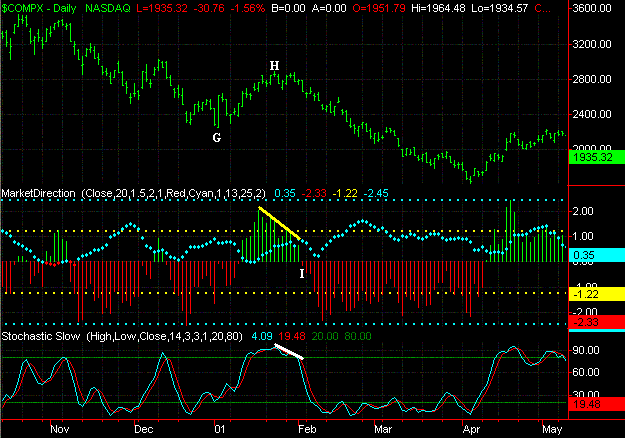
2000
After peaking in the Spring of 2000 (point J) the Nasdaq tries
to rally again but the buying pressure is very weak (downward sloping yellow
line). In addition the %K Line is trending downward as well (solid
white line). Furthermore the Green Bar then changes to a Red Bar
indicating increasing selling pressure (point K). During the next four
weeks the Nasdaq drops from 5000 to 3300 for a net loss of 1700
points.
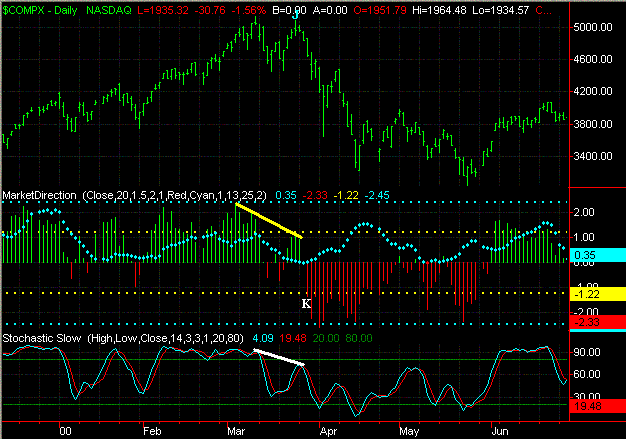
1999
The Nasdaq rallies strongly in June and July (points M to N) but
the Buying Pressure begins to diminish (downward sloping yellow line). The
%K Line in this case is still above 90 but then crosses below its %D Line and
drops below 80 (point O). In addition the Green Bar changes to color to a
Red Bar indicating increasing selling pressure (point P). During the next
three weeks the Nasdaq drops from 2850 to 2450 for a loss of 400 points.

1998
Two examples of overbought conditions occurred in 1998.
The first one occurred in the Fall of 1998 after the Nasdaq rallied for about
five weeks (points Q to R) however the Buying Pressure was on the decrease
(downward sloping yellow line). In addition the %K Line also began to
trend downward as well (solid white line). Meanwhile the Green Bar
changed color to a Red Bar indicating increasing Selling Pressure (point
S). During the next two weeks the Nasdaq then dropped from 1750 to
1400 for a loss of 350 points.
A second example occurred in the Summer of 1998 as the Nasdaq
rallied for several weeks (points T to U). However towards the end of its
run the Buying Pressure began to diminish (downward sloping yellow
line). In this case the %K Line still remained above 90 but
eventually dropped below its %D Line and fell below 80 (point V).
Meanwhile the Green Bar switched to a Red Bar as the selling pressure began to
increase (point W). During the next six weeks the Nasdaq then dropped from
2050 to 1500 for a loss of 550 points.
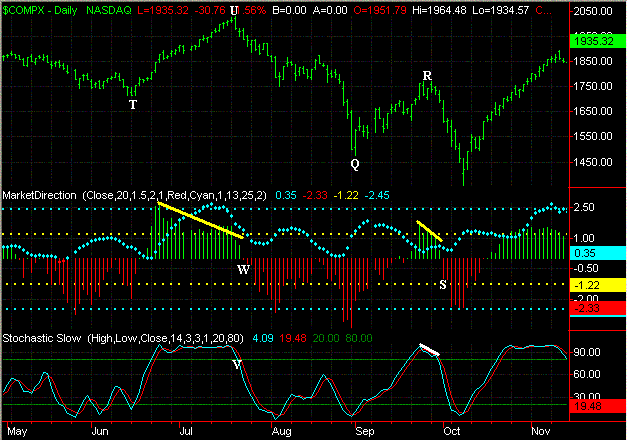
1997
The Nasdaq rallies in the Fall of 1997 (points V to W) but the
Buying Pressure begins to diminish in October (downward sloping yellow
line). Also the %K Line crosses below its %D Line and drops below 80
(point X). In addition the Green Bar then changes color to a Red Bar
indicating increasing Selling Pressure (point Y). During the next
three weeks the Nasdaq drops from 1750 to 1450 for a loss of 300 points.
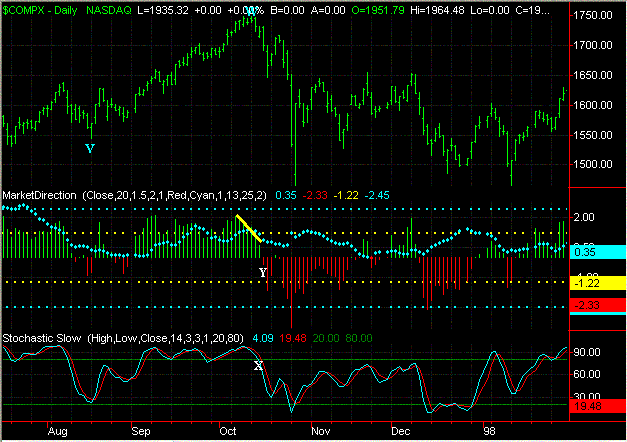
1996
During 1996 the Nasdaq rises for several weeks (points A to B)
but then loses steam by early that Summer as the Buying Pressure begins to
diminish (downward sloping yellow line). In addition the %K Line also is
also sloping downward as well (solid white line). Meanwhile the Green Bar
eventually changes color to a Red Bar (point C). During the next two
months the Nasdaq drops from 1250 to 1000 for a loss of 250 points.
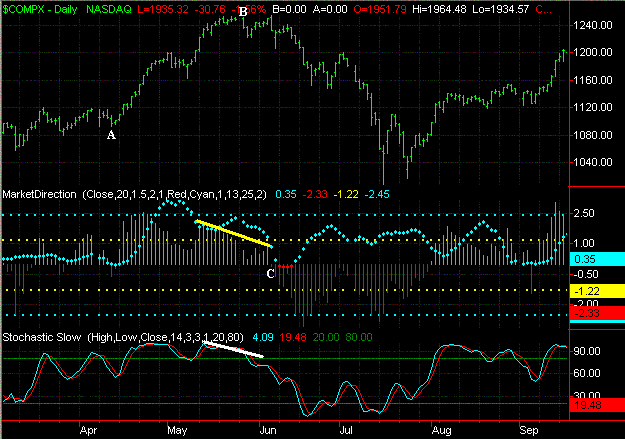
The main things to notice in these examples as the market
becomes overbought and is nearing a top and downside reversal are the following:
1. The %K Line in association with the Slow Stochastics
first rises above 90.
2. The amount of Buying Pressure begins to diminish (depth of successive
Green Bars decreases).
3. The %K Line in association with the Slow Stochastics is trending downward as the market makes a higher high.
4. The %K Line crosses below the %D Line and drops below 80 in association
with the Slow Stochastics.
5. After a series of successive Green Bars (Buying Pressure) the color changes to a Red Bar
which is indicative if increasing Selling Pressure.
Click Here to
see what our current Market Timing Indicator (MTI) is showing for the Major
Averages
|



